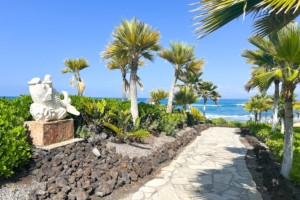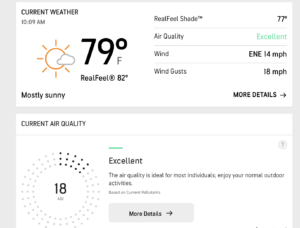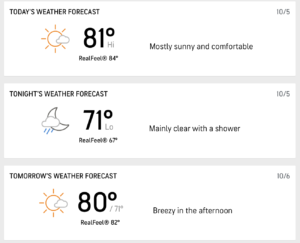Did you see the title and think “every season is great”? You’re not wrong!

The simple answer is that it’s always beautiful in Hawai’i but let’s look at a few things to consider when you’re planning your trip. The most obvious consideration is the weather where you live. Is it October and you just got 4 inches of snow with the possibility of 79 more over the next 5 months? Or even worse, is it 40 degrees and rainy? Are you thinking about the -17 wind chill in your future? The consistent beautiful weather helps but other factors are crowds and prices throughout the year that can help you make the most out of your Hawaiian adventure. So let’s dive in and answer the question. What is the best season to visit Hawai’i?
Understanding the Seasons in Hawaii
Hawaii experiences minor temperature changes throughout the year, with an average daytime temperature of 85°F in the summer and 78°F in the winter. While the weather remains pleasant year-round, there are some variations in precipitation and surf conditions that can impact your trip.
Summer (June to August)
If you want to experience Hawaii at its best, summer is the ideal time to visit. The days are long, the weather is almost always sunny, and there’s a wide range of activities to enjoy. However, keep in mind that summer is also the peak season for traveling to the islands, as schools are out on summer break. This means higher prices on airfare and hotels, as well as busier beaches and activities.
During the summer, south-facing shores like Waikiki on Oʻahu and Poʻipu on Kauaʻi offer excellent surfing opportunities. Additionally, there are numerous outdoor events and festivals taking place on every island. From the annual King Kamehameha Celebration Floral Parade through Waikiki to Japanese temple bon dances, there’s something for everyone. Moreover, summer is the perfect time to enjoy the blooming plumeria trees and indulge in the abundance of mangoes available in restaurants and farmers’ markets across the state.
Fall (September to October)
Fall is typically the slower season for travel in Hawaii, making it an excellent choice for budget-conscious travelers. With fewer crowds and warm temperatures averaging a high of 88°F, you can enjoy a more relaxed and affordable vacation. Airfare from the US mainland tends to be at its lowest during this time, and finding deals on hotels is relatively easier.
While fall offers comfortable weather, it’s important to note that it is still hurricane season until November. Although the Islands have seen only a handful of significant hurricanes since 1950, it’s wise to keep an eye on the weather forecast. Most hurricanes hit the islands in late summer and early fall, so it’s always good to be prepared.
Winter (November to January)
Winter in Hawaii is a popular time to escape colder climates, resulting in increased tourism. The last two weeks of December through early January are the busiest times, with hotels and flights often booked to capacity. Prices for airfare and accommodations are at their highest during this period, so it’s advisable to book well in advance.
Despite the crowds, winter in Hawaii has its own unique charm. The best time to surf on the Big Island is November-April when the winds bring consistent north westerly swells. The fabled North Shore of Oʻahu experiences monster surf, attracting professional surfers from around the world. You can witness exciting surf contests such as the Triple Crown of Surfing and the Eddie Aikau Big Wave Invitation. Additionally, the Honolulu Marathon takes place in December, and the humpback whales start their annual migration to the warm Hawaiian waters, providing excellent opportunities for whale watching. Check out Body Glove Hawai’i for some amazing trips.
Late Winter (February and early March)
Late winter offers an excellent opportunity for budget travelers and those seeking a more relaxing vacation. With discounts on airfare and hotels, and fewer crowds at beaches, hiking trails, and popular attractions, you can enjoy a more tranquil Hawaiian experience. Check here for a list of great hikes. I would also add Pu’u O’o Trail which starts along the Saddle Road and takes you through several landscapes and in and out of Lava Flows. Although this period can be rainier than summer, the showers are usually localized and short-lived.
Spring (Mid-March to early April)
Spring is generally a slower time of year for travel in Hawaii. With cool and comfortable weather, it’s an ideal time for outdoor adventures with kids. The ocean is calm, making it perfect for snorkeling and swimming. In case of rain, there are plenty of indoor activities to enjoy, such as visiting indoor playgrounds or attending a luau.
Next Steps?
Book a place to stay
Hawaii is a dream destination with its stunning beaches, vibrant culture, and year-round sunshine. While any time is a good time to visit, understanding the seasonal variations in weather, crowds, and events can help you plan the perfect Hawaiian getaway. Whether you prefer the bustling summer atmosphere, the budget-friendly fall season, or the excitement of winter events, Hawaii offers something for everyone. It could be said that every season is the best season. So pack your bags and get ready to embark on a truly unforgettable Hawaiian adventure!
Image Source: Unsplash





